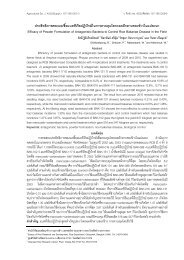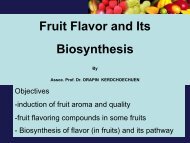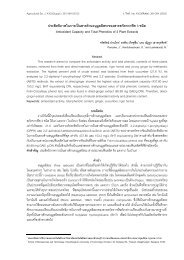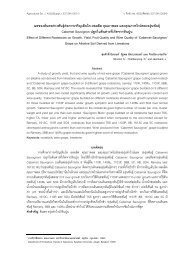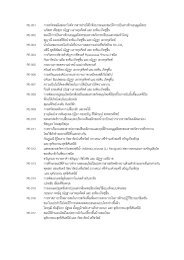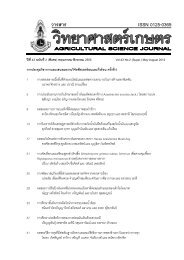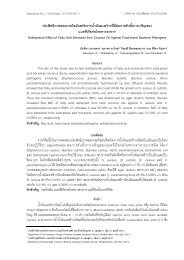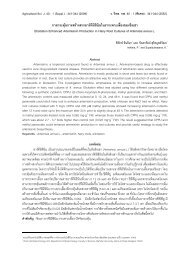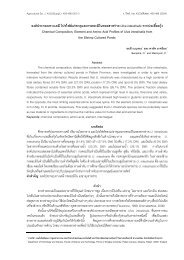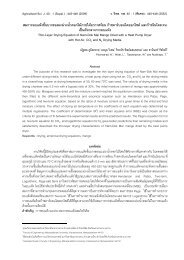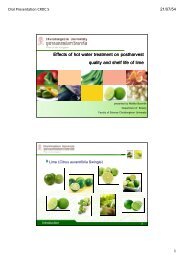Persicaria odorata Antibacterial Activity of the ... - ResearchGate
Persicaria odorata Antibacterial Activity of the ... - ResearchGate
Persicaria odorata Antibacterial Activity of the ... - ResearchGate
Create successful ePaper yourself
Turn your PDF publications into a flip-book with our unique Google optimized e-Paper software.
Agricultural Sci. J. 42(2)(Suppl.): 105-108 (2011) ว. วิทย์. กษ. 42(2)(พิเศษ): 105-108 (2554)องค์ประกอบทางเคมี และประสิทธิภาพการเป็ นสารต้านแบคทีเรียของนํามันหอมระเหยจากใบ <strong>Persicaria</strong> <strong>odorata</strong><strong>Antibacterial</strong> <strong>Activity</strong> <strong>of</strong> <strong>the</strong> Essential Oil from <strong>Persicaria</strong> <strong>odorata</strong> Leavesพราโมโน สาสงโก้1,2 ณัฎฐา เลาหกุลจิตต์2 และ อรพิน เกิดชูชื น 2Sasongko, P. 1,2 , Laohankunjit, N. 2 and Kerdchoechuen, O. 2AbstractThis study conducted to identify physicochemical properties and antibacterial activity <strong>of</strong> <strong>the</strong> essentialoils from Vietnamese Coriander (<strong>Persicaria</strong> <strong>odorata</strong>). Hydrodistillation was used to extract <strong>the</strong> essential oil from<strong>the</strong> fresh and dry leaves <strong>of</strong> <strong>Persicaria</strong> <strong>odorata</strong>. Using a Gas Chromatography-Mass Spectrometry (GC-MSanalysis), dodecanal, caryophyllene, alpha-caryophyllene, drimenol and decanal were identified as a majorvolatile compounds. The antibacterial testing was conducted by disc diffusion method. The essential oils fromboth <strong>of</strong> fresh and dry leaves <strong>of</strong> <strong>Persicaria</strong> <strong>odorata</strong> exhibited antibacterial activity against both <strong>of</strong> gram positivebacteria such as Staphylococcus aureus and gram negative bacteria such as Escherichia coli. Moreover, <strong>the</strong>highest antibacterial activity was shown by essential oil from dry leaves which against S. aureus exhibited aninhibition zone at 26 mm for 100µl/ml concentration.Keywords: <strong>Persicaria</strong> <strong>odorata</strong>, essential oil, gas chromatography-mass spectrometry, antibacterial activityบทคัดย่องานวิจัยนี ศึกษาองค์ประกอบทางเคมี และประสิทธิภาพการเป็ นสารต้านแบคทีเรียของนํ ามันหอมระเหยจากผักแพว (<strong>Persicaria</strong> <strong>odorata</strong>) อบแห้งและสด ทีสกัดโดยการต้มกลัน ซึงนํ ามันผักแพวมีสารหอมระเหยได้ วิเคราะห์ด้วยเครืองgas chromatography-mass spectrometry (GC-MS) ได้แก่ dodecanal, caryophyllene, alpha-caryophyllene,drimenol และ decanal เมือนํามาทดสอบประสิทธิภาพการเป็ นสารต้านแบคทีเรียด้วยวิธี disc diffusion method พบว่านํ ามันหอมระเหยจากใบผักแพวสดและแห้ง มีความสามารถยับยั งแบคทีเรียแกรมบวก เช่น Staphylococcus aureus และแกรมลบ เช่น Escherichia coli ได้ นอกจากนี นํ ามันหอมระเหยจากผักแพวอบแห้งมีประสิทธิภาพยับยั งการเจริญของเชื อแบคทีเรีย S. aureus ได้สูงสุด เมือใช้ความเข้มข้น 100µl/ml โดยมีค่า inhibition zone เท่ากับ 26 มิลลิเมตรคําสําคัญ: <strong>Persicaria</strong> <strong>odorata</strong> นํ ามันหอมระเหย gas chromatography-mass spectrometry ประสิทธิภาพการต้านเชื อแบคทีเรียIntroductionEssential oils have a significant role in <strong>the</strong> society where <strong>the</strong>y are variously used in medicine,pharmacy, cosmetics, chemical and food-processing industries (Yentema et al., 2007). Essential oils areimportant constituent <strong>of</strong> some higher plants comprising monoterpenes, sesquiterpenes, arylpropanoids ando<strong>the</strong>r derivatives. The antimicrobial properties <strong>of</strong> essential oils have been recognized for long time and <strong>the</strong>yhave been scientifically established (Sadashiva et al., 2010). Essential oils are very complex natural mixtureswhich contain about 20–60 components at quite different concentrations. They are characterized by two orthree major components at fairly high concentrations (20–70%) compared to o<strong>the</strong>r components present intrace amounts (Bakkali et al., 2008). Moreover, it has been reported that essential oil has biological activitiessuch as an antimicrobial, antioxidant, antifungal and anticancer activity. The simple and complex derivatives <strong>of</strong>phenol are main antimicrobial compounds in essential oils from spices (Conner, 1993). Coriandrum sativumessential oil was reported that has an antibacterial activity against ei<strong>the</strong>r gram positive or gram negativebacteria (Matasyoh et al., 2009). Fur<strong>the</strong>rmore, Laohakunjit et al. (2008) concludes that essential oil from1Faculty <strong>of</strong> Agriculture Technology, University <strong>of</strong> Brawijaya, Malang 65141, Indonesia2School <strong>of</strong> Bioresources and Technology, King Mongkut’s University <strong>of</strong> Technology Thonburi 83 Moo 8 Tha-kam, Bangkhuntien, Bangkok 10150
106 ปี ที 42 ฉบับที 2 (พิเศษ) พฤษภาคม - สิงหาคม 2554 ว. วิทยาศาสตร์เกษตรKaempferia (Boesenbergia pandurata Holtt.) and Bastard cardamom (Amomum xanthioides Wall) has anantibacterial effect towards Escherichia coli, Staphylococcus aureus, Bacillus cereus and Listeriamonocytogenes. <strong>Persicaria</strong> <strong>odorata</strong> is a native plant <strong>of</strong> sou<strong>the</strong>astern Asia. The taste <strong>of</strong> <strong>Persicaria</strong> <strong>odorata</strong> isdescribed as being pungent and spicy, and its smell is similar to coriander with hints <strong>of</strong> a lemon scent. Volatilecompound from essential oil <strong>of</strong> <strong>Persicaria</strong> <strong>odorata</strong> contains aldehyde such as decanal (Anonymous, 2010).Fur<strong>the</strong>rmore, <strong>the</strong> plant was extracted by different condition and extraction methods. The difference inorganoleptic pr<strong>of</strong>ile indicates a difference in <strong>the</strong> composition <strong>of</strong> oils which were obtained by different conditionand this may also influence on chemical and volatile properties (Hashemi et al., 2008). This study was aimedto identify physicochemical properties and antibacterial activity <strong>of</strong> <strong>the</strong> essential oil from fresh and dry leaves <strong>of</strong>Vietnamese Coriander (<strong>Persicaria</strong> <strong>odorata</strong>).Materials and MethodsPlant materials: Leaves <strong>of</strong> <strong>Persicaria</strong> <strong>odorata</strong> were purchased from a local vegetable and fruit market <strong>of</strong> <strong>the</strong>Thungkru District, Bangkok, Thailand. For dry sample, <strong>the</strong> leaves were washed to remove soil, peeled,chopped and dried by oven dryer at 40°C for 24 h to reduce <strong>the</strong> water content.Oil Isolation: 1000 g and 500 g <strong>of</strong> fresh and dried leaves <strong>of</strong> <strong>Persicaria</strong> <strong>odorata</strong> were hydrodistilled inClevenger-type apparatus for 24 h. Essential oil was collected and stored in <strong>the</strong> dark vial at 4°C.Physical properties analysis. Physical properties such as percentage <strong>of</strong> yield extraction, color and refractiveindex were observed. Color <strong>of</strong> essential oil was determined using Hunterlab mini scanEZ Color Reader.Refractive index <strong>of</strong> <strong>the</strong> oil was determined by Hand-held Refractometer.Gas Chromatography-Mass Spectrometry analysis: An aliquot <strong>of</strong> 1 µl oils (dissolved in ethanol) was adjustedto 100 ppm after that it was directly injected into GC-MS Agilent 7890A which was carried out in GC-MSsystem, fitted with a 30 m x 0.25 mm i.d. x 0.25 µm film thickness, DB-5ms capillary column. The carrier gaswas helium at flow rate 0.57 ml/min. The injector and detector temperatures were 230 o C and 250 o C,respectively. The running methods were splitless mode, pressure: 3 psi, oven temperature: 70 o C <strong>the</strong>n rate at10 o C/min to 140 o C, and <strong>the</strong>n rate at 5 o C/min to 240 o C.<strong>Antibacterial</strong> activity: <strong>Antibacterial</strong> activity assays were carried out by disc diffusion method. OvernightStaphylococcus aureus and Escherichia coli bacterial suspension (50 µl) adjusted to contain 1x10 6 CFU/ml <strong>of</strong>bacteria by spectrophotometer compared with MacFarland no. 0.5, which OD must be between 0.008-0.1.Bacterial suspension was spread by a sterile glass spreader on Muller-Hinton Agar (MHA) medium. Sterile 6mm filter paper (Whatman No.1) disc was impregnated with 100µl/ml <strong>of</strong> <strong>the</strong> essential oil that dissolved in steriledimehtylsulfoxide (DMSO) and put in <strong>the</strong> inoculated plates. The inoculated plates were incubated at 37±2 o C for24h and <strong>the</strong>n <strong>the</strong> inhibition zones were measured in diameter (mm) around <strong>of</strong> <strong>the</strong> disc. DMSO was used asnegative control. Streptomycin (5mg/ml) was used for positive control. The assays were performed with threereplicates.Minimum Inhibition Concentration (MIC) value: MIC value was carried out in disc diffusion assay. Plant extractsdissolved in DMSO were first diluted to <strong>the</strong> highest concentration (50 µl/ml) and <strong>the</strong>n serial two-fold dilutionswere made in a concentration range from 6.25 µl/ml to 50 µl/ml. The least concentration <strong>of</strong> each extractshowing a clear <strong>of</strong> inhibition was taken as <strong>the</strong> MIC levels. DMSO was used as negative control andstreptomycin (5mg/ml) was used for positive control.Results and DiscussionThe essential oil was recovered from 1000 g fresh and 500g from dry leaves <strong>of</strong> <strong>Persicaria</strong> <strong>odorata</strong>which extracted by hydrodistillation methods showed a % yield at 0.274% and 0.12%, respectively (Table 1).Yield <strong>of</strong> essential oil from dry leaves was lower than fresh leaves because some <strong>of</strong> volatile compound from dry
ว. วิทยาศาสตร์เกษตร ปี ที 42 ฉบับที 2 (พิเศษ) พฤษภาคม - สิงหาคม 2554 107leaves has been vaporized in drying process. Color measurement result showed that <strong>the</strong> color <strong>of</strong> essential oilfrom fresh and dry leaves in 2000 ppm concentration was light yellow green. Moreover, refractive index values<strong>of</strong> essential oil from fresh and dry leaves are 1.472 and 1.471, respectively, this refractive index value wassimilar to refractive index <strong>of</strong> some spice and herbs oil which in range <strong>of</strong> 1.462-1.600 (Singhal et al., 2001).Gas Chromatography-Mass Spectrometry chromatogram results were compared with Wiley275 andNIST library used a % quality greater than 85%. RI value was calculated with a DB-5ms stationary phase usinga series <strong>of</strong> n-alkanes standard between C 10 and C 20 . There are 26 volatile compounds contained in essential oilfrom fresh and dry leaves <strong>of</strong> <strong>Persicaria</strong> <strong>odorata</strong> (Table 2). The major volatile compounds from both <strong>of</strong> fresh anddry leaves are eupatoriochromene (21.71% and 20.94%), dodecanal (19.96% and 18.72%), alphacaryophyllene(12.57% and 11.62%), beta-caryophyllene (11.07 % and 11.40%) and decanal (7.32 % and4.47%), respectively. O<strong>the</strong>rs compound such as eucalyptol, alpha,-curcumene, eremophilene and drimenolwere also detected in trace amount.Fur<strong>the</strong>rmore, as shown in Table 3, <strong>the</strong> essential oil from fresh and dry leaves <strong>of</strong> <strong>Persicaria</strong> <strong>odorata</strong>possess strong antibacterial activity against gram positive bacteria: Staphyloccocus aureus and gramnegative bacteria such as Escherichia coli. Essential oil from fresh and dry leaves produced an average zone<strong>of</strong> inhibition (ZOI) <strong>of</strong> 21 and 26 mm against S. aureus and average ZOI against E. coli are 13 and 19 mm,respectively. Essential oil from <strong>Persicaria</strong> <strong>odorata</strong> leaves has been known as source <strong>of</strong> aldehyde and terpenecompound such as dodecanal, decanal, caryophyllene, eremophillene and alpha-curcumene which arepossess antibacterial properties (Sadashiva et.al., 2010). The lowest concentrations that can inhibit <strong>the</strong> growth<strong>of</strong> bacteria were shown by MIC values at 6.25 µl/ml for S. aureus and 12.5 µl/ml for E.coli. Although, averageZOI <strong>of</strong> <strong>the</strong> E. coli was lower than S. aureus, <strong>the</strong> MIC value <strong>of</strong> essential oil against E. coli was higher thanagainst S. aureus because <strong>the</strong> essential oil has a better activity against gram positive bacteria (S. aureus) thangram negative bacteria (E. coli) and gram negative bacteria was more resistant. A gram negative bacteriaresistance was influenced by <strong>the</strong> structure <strong>of</strong> cell wall. Gram negative bacteria have an outer and innermembrane in <strong>the</strong>ir cell wall which is more complicate compared with gram positive bacteria cell membrane(Anonymous, 1999).SummaryThe major volatile compounds <strong>of</strong> essential oil from fresh and dry leaves <strong>of</strong> <strong>Persicaria</strong> <strong>odorata</strong> waseupatorichromene, dodecanal, alpha-caryophyllene, beta-caryophyllene and decanal. Fur<strong>the</strong>rmore, this oil hasa strong antibacterial activity against both <strong>of</strong> gram positive and gram negative bacteria. The MIC value <strong>of</strong>essential oil from fresh and dry leaves <strong>of</strong> <strong>Persicaria</strong> <strong>odorata</strong> against S.aureus and E.coli are 6.25 µl/ml and12.5 µl/ml, respectively.AcknowledgementThis work was supported by <strong>the</strong> Higher Education Research Promotion and National ResearchUniversity Project <strong>of</strong> Thailand, Office <strong>of</strong> <strong>the</strong> Higher Education Commission.Literature citedAnonymous, 2010, <strong>Persicaria</strong> <strong>odorata</strong> [online], available: http://en.wikipedia.org/wiki/Vietnamese_coriander[2011, 11 th February].Anonymous. 1999, Physiology & Biochemistry Of Microorganisms, [online], available: http://www.micro.siu.edumicr425/425Notes/01-Introduction.html. SIUC / College <strong>of</strong> Science / Microbiology. [2010, November 28 th ].Bakkali, F., Averbeck, S., Averbeck, D. and Idaomar, M., 2008, Biological Effects <strong>of</strong> Essential Oils – A review,Journal <strong>of</strong> Food and Chemical Toxicology, 46(2): 446-475.
106 108ปี ที 42 ฉบับที 2 (พิเศษ) พฤษภาคม - สิงหาคม 2554 ว. วิทยาศาสตร์เกษตรConner, D.E., 1993, Naturally Occurring Compounds, pp. 441-468. In P.M. Davidson and A.L. Branen (eds.).Antimicrobials in Foods. 2nd ed. Marcel Dekker, Inc., New York.Hashemi, P., Abolghasemi, M.M., Ghiasvand, A.R., Ahmadi, S., Hassanvand, H. and Yarahmadi, A., 2008, AComparative Study <strong>of</strong> Hydrodistillation and Hydrodistillation–Solvent Microextraction Methods forIdentification <strong>of</strong> Volatile Components <strong>of</strong> Echinophora cinerea, Journal <strong>of</strong> Chromatographia, 69: 179-182.Matasyoh, J.C., Maiyo, Z.C., Ngure, R.M. and Chepkorir, R., 2008, Chemical Composition and Antimicrobial<strong>Activity</strong> <strong>of</strong> The Essential Oil <strong>of</strong> Coriandrum sativum, Journal <strong>of</strong> Food Chemistry, 113(2): 526-529.Laohakunjit, N., * Orapin, K., Krittika, N. and Pantip, B, 2008, Essential Oil from Five Zingiberaceae for AntiFood-Borne Bacteria, International Food Research Journal, 15(3): 337-346.Singhal, R.S., Kulkarni, P.R. and Rege, D.V., 2001, Quality Indices for Spice Essential Oils, Chapter 3 pp. 30.InPeter, K.V., Handbook <strong>of</strong> Herbs and Spices, CRC Press, USA.Sadashiva, C.T., Sharanappa, P., Remashree, A.B., Raghu, A.V., Udayan, P.S. and Balachandran, I., 2010,Chemical Composition and Antimicrobial <strong>Activity</strong> <strong>of</strong> <strong>the</strong> Essential Oil from Bark <strong>of</strong> Pittosporum dasycaulonMiq., Advances in Biological Research, 4(6): 301-304.Yentema, O., Alioune, O. and Dorosso, S.A., 2007, Chemical Composition and Physical Characteristic <strong>of</strong> <strong>the</strong>Essential oil <strong>of</strong> Cymbopogon schoenanthus (L.) Spreng <strong>of</strong> Burkina Faso, Journal <strong>of</strong> Applied Sciences,7(4): 503-506.Table 1 Physical properties <strong>of</strong> essential oil from fresh and dry leaves <strong>of</strong> <strong>Persicaria</strong> <strong>odorata</strong>Sample Yield <strong>of</strong> extraction L* a* b* c* Hue angle Color appearance Refractive index(%)-dry basisFresh 0.274 70.61 -0.86 2.50 2.64 108.99 Light green 1.472Dry 0.120 69.96 -0.86 2.26 2.42 110.83 Light yellow 1.471Table 2 Constituent <strong>of</strong> <strong>the</strong> essential oil from fresh and dry leaves <strong>of</strong> <strong>Persicaria</strong> <strong>odorata</strong>No. Volatile compounds RI a Composition (%)No. Volatile compounds RI a Composition (%)Fresh Dry Fresh Dry1. eucalyptol 1051 0.31 - 14. alpha,-curcumene 1490 3.16 4.492. undecane 1108 - 0.14 15. eremophillene 1508 6.89 4.203. 1-nonanol 1174 - 0.09 16. 7-epi-alpha-selinene 1537 - 2.594. decanal 1212 7.32 4.47 17. ledol 1550 5.99 -5. decanol 1274 - 3.34 18. nerolidol 1564 - 3.676. undecanal 1311 0.58 0.57 19. globulol 1587 0.95 -7. n-decanoic acid 1358 0.21 - 20. caryophyllene oxide 1601 2.04 5.648 1-nonene 1374 - 2.02 21. cubenol 1640 0.08 -9. beta-elemene 1401 0.64 - 22. eupatoriochromene 1664 21.71 20.9410. dodecanal 1417 19.96 18.72 23. drimenol 1790 4.74 4.3411. beta-caryophyllene 1441 11.07 11.40 24. hexahydro farnesyl acetone 1842 - 0.6012.13.allo-aromadendrenalpha.-caryophyllene145614760.4912.57-11.6225.26.isophytoln-hexadecanoic acid194519590.390.910.170.99a Retention indices calculated based on n-alkane standard (C 10 -C 20 )Table 3 <strong>Antibacterial</strong> activity and Minimum inhibitory concentration (MIC) value <strong>of</strong> essential oil from fresh anddry leaves <strong>of</strong> <strong>Persicaria</strong> <strong>odorata</strong>Bacterial speciesInhibition zones (mm)*MIC value(µl/ml)Fresh Dry DMSO** Streptomycin (5mg/ml)*** Fresh DryS. aureus 21 26 - 23 6.25 6.25E. coli 13 19 - 20 12.5 12.5*Inhibition zone including <strong>the</strong> diameter <strong>of</strong> <strong>the</strong> paper disc (6 mm); ** Negative control (DMSO); *** Positive control (5mg/ml Streptomycin)



